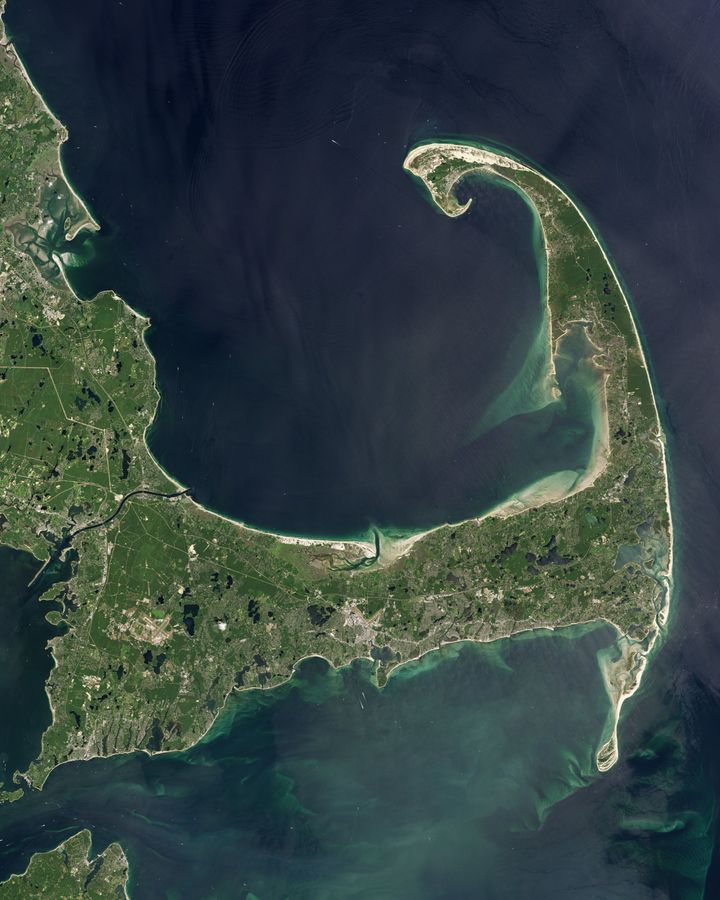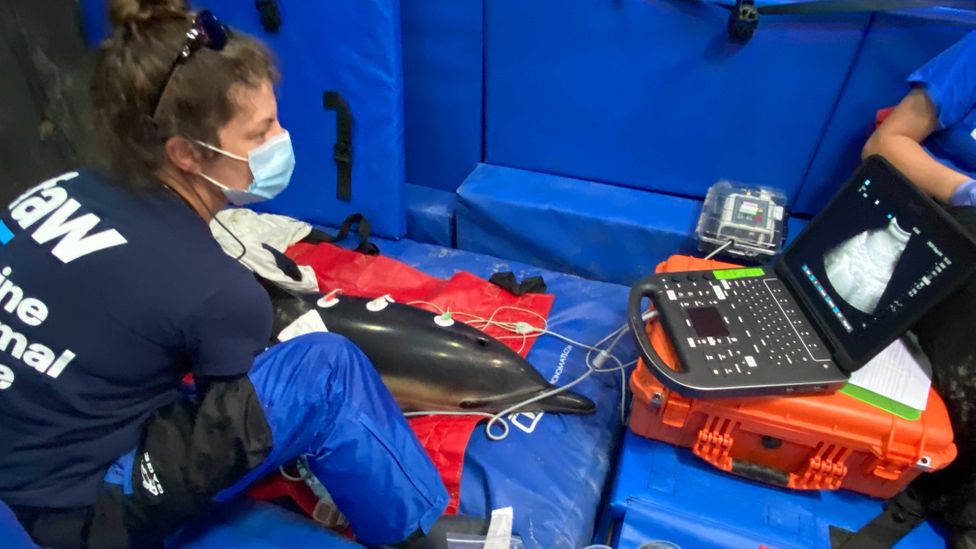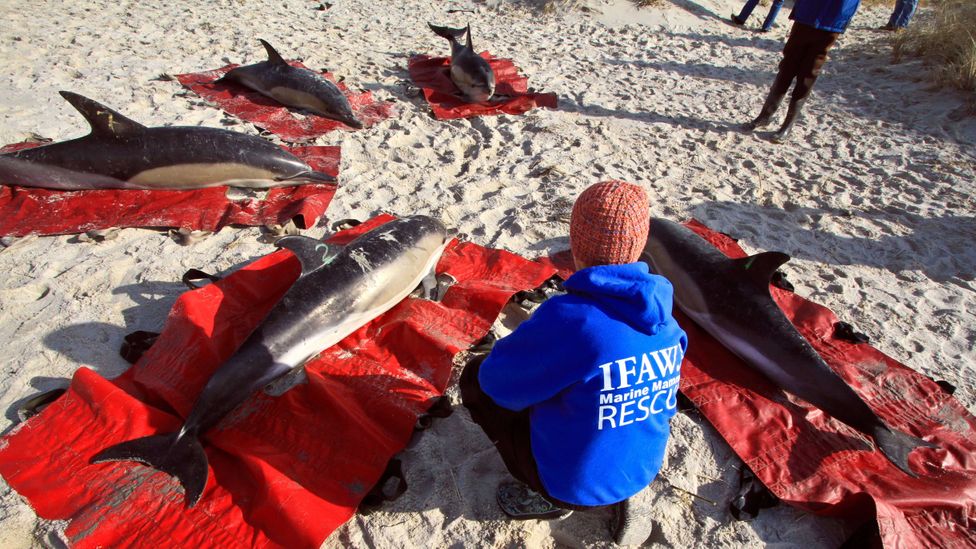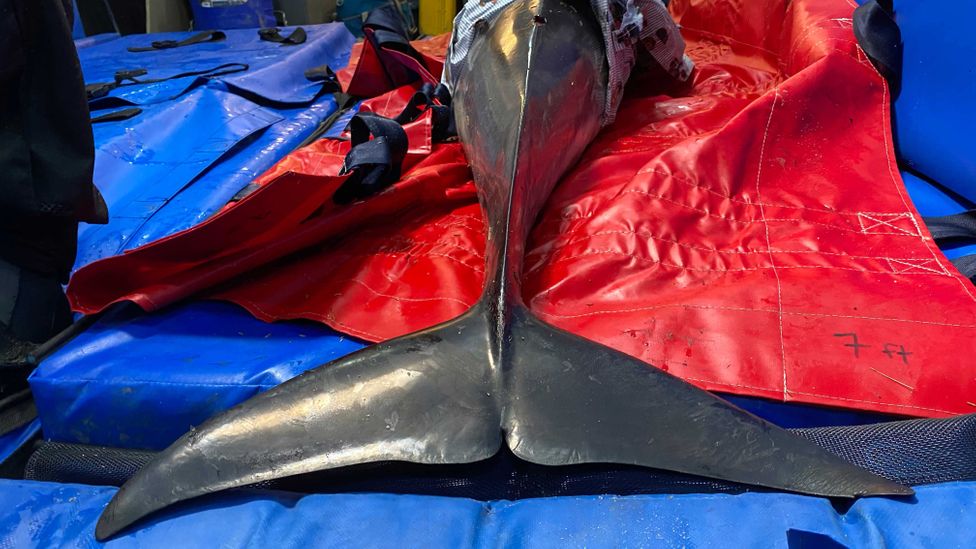It’s the heavy breath that’s so striking. A gulp of air, drawn by the dolphin calf’s collapsing lungs as it lies stranded on the sands of Cape Cod, Massachusetts. There’s something almost human about the desperate gasp from its blowhole, which makes the sound all the more harrowing.
“When these dolphins strand it’s equivalent to a human being in a car accident,” explains Brian Sharp, the director of the International Fund for Animal Welfare’s (Ifaw) sea mammal rescue team. “They’re feeling the full effects of gravity for the first time, plus the stress and shock.”
The calf has not only been separated from its mother, who has beached 20m further along the shore, it’s also entered an alien world hostile to survival.
The seawater around the calf is rapidly draining with the tide. Stuck in shallow, seaweed-tangled water, the sensitive skin of a dolphin can develop third-degree burns in minutes if left unprotected in the summer sun. The stress of the stranding can also lead to capture myopathy syndrome, where dehydration and exhaustion combine to create rapid, stress-induced muscle degeneration. Heart muscles can often be the first to go.
More dolphins run aground on this stretch of Cape Cod shoreline than almost anywhere in the world. More than 400 strandings happened in 2019, and in August 2020, 45 dolphins beached in one day alone.
The good news is that the Ifaw team has shown it is possible to increase survival rates from such strandings significantly. “When we started doing this back in 1998, the release rate was barely 14%,” says Sharp. “Over the years, as we’ve introduced new technology, new protocols, new techniques; that percentage has increased to over 78%.”
And they are not the only groups using new approaches to save beached ocean mammals. So, what’s changed, and what might the future hold for rescuing greater numbers of these charismatic sea creatures?
You may also like:
- Listen to the author’s BBC World Service radio piece: “Saving Cape Cod’s dolphins”
- The floating gardens of Bangladesh
- The world’s growing concrete coasts
The tidal range of Cape Cod Bay is so large that over 50 sq km (19 sq miles) of sand flats are revealed by the retreating water every day. For the pods of dolphins who chase their food here, the shallows can all too quickly turn into a maze of draining water. In the past, the chances of survival were poor.
“Prior to 2010, the leading thinking was that anytime a single dolphin stranded the animal must be sick, diseased, separated from its group and the only responsible thing to do was euthanise it. [But] we can give the animal a second chance,” Sharp adds.

The distinctive curled bicep of Cape Cod, where dolphins are often stranded in shallow waters (Credit: Nasa)
One thing that has changed for groups like Ifaw is the introduction of new technology. Across the 1,100km-plus (700 miles) coastline of Cape Cod, the Ifaw team uses a bespoke app to help coordinate their 220-strong volunteer team to respond quickly to stranding emergencies. It allows rapid communication of stranding locations so those volunteers closest and with the most relevant training, can be on site as quickly as possible.
To add to the app, they also have a fully-equipped mobile healthcare unit, or ambulance. Here IV drips, blood tests, ultrasound organ scans and heart monitoring can be administered to rescued dolphins while they are driven to the nearest deepwater release site at the tip of the peninsula.
But such technology is no panacea, and is only part of the story.
Emergency treatment
Back at the calf and mother stranding, Ifaw’s lead vet, Sarah Sharp [Brian’s wife], has arrived on the scene. The two dolphins are placed on tarpaulin stretchers, lifted onto a beach-adapted cart and wheeled to the ambulance in the car park. But within moments of getting into the trailer, disaster strikes.
“Unfortunately I can’t get a heart beat in her right now,” Sarah says, confirming the mother’s loss of life through the silence of her stethoscope. As the ambulance pulls onto the road, all attention within the trailer immediately moves to the calf. Its blood tests and organ scans display good health, despite the bumps of the journey and the stifling heat of the day.
The plan is to attach a satellite tag to its anesthetised fin. The device, which costs nearly $2,000 (£1,535), allows Ifaw to track individuals returning to local pods as well as other movements and behaviours. But as the team ready to clip it through the calf’s cartilage, it bucks and twitches in panic just as its mother had earlier in the day.

The Ifaw team tend to a stranded calf dolphin (Credit: Ben Wyatt)
Ice water and wet sheets are rushed onto its body, calming its heart rate enough to avoid cardiac arrest and for the tag to be applied as we pull up to the release site. The calf is now carefully lifted back on to the cart, pushed across the parking lot and the beach and into the waves. As a crowd of people gather to watch, Sarah and her assistant vet slide the dolphin into the sea water and hold it steady as it regains its bearings. Only the calf is no longer moving.
With its life hanging in the balance, the complexity of the challenge facing Ifaw’s team is all too clear. It is also begs the question, what could be done to improve survival rates further?
Sound science
A little way down the coast is Wellfleet Harbour, the notorious hotspot for strandings where those 45 dolphins beached in August. This is where I meet Laela Seak, a biology research specialist from the Woods Hole Oceanographic Institute. We climb aboard the harbour master’s boat where she tells me about her team’s project.
“We’ve been deploying a sound recording device in the entrance to Wellfleet Harbour, on and off, for the past six years or so. We’ve placed it there in the hope that we can detect the sounds of dolphins before they’re about to strand,” Seak tells me.
“If we could discern certain features of the sounds they make before they strand, we might be able to develop an acoustic stranding alert system [to] transmit this information to the stranding responders and give them more time.”
After a short ride across the millpond calm waters we reach a buoy which, when pulled into the boat has the tin-can sized audio recorder attached to it via a chain. Back on shore, Seak plays me an example of the sounds she’s managed to capture on the device.
Seak and her team were particularly interested in signature whistles – distinct communications used by dolphins to locate one another, particularly in social situations. In times of stress, dolphins produce them much more frequently and so Seak’s team hypothesised that a stranding event would produce a spike.

A Cape Cod stranding back in 2012, when less-developed technology made it harder to save dolphins (Credit: Vincent DeWitt/Alamy)
Potentially, the cetacean chatter in the bay’s water could then be the foundation to an automatic alarm system sensitive enough to predict beachings. Which all sounds great, if it wasn’t for one major problem:
“It’s very time intensive to go through the recordings. We look at these recordings visually and mark where we see these distinctive signature whistles. Ultimately, if we’re going to set up a mass stranding alert system the process is going to have to be automated.”
Automated and, to be more precise, the process needs to be intelligent too. Which is where a project of Google comes in. The tech-giant was already using machine learning to process large amounts of audio on YouTube.
Julie Cattieu, from Google's “AI for social good” team, told me the software used two million hours of Youtube videos to train itself to identify sound events like a person laughing or crying. These sound events could then be added as contextual information to the video’s captions.
“As long as we have an expert who can detect specific sounds, chances are we can teach the algorithm to detect the same sounds using training data,” Cattieu explains.
The team wanted to see if the algorithm could be used to detect animal sounds too, so they contacted Ann Allen, from National Oceanographic and Atmospheric Administration (Noaa) in Hawaii. Allen possessed a vast archive of audio collected from marine life living in the waters of South Pacific US territories: more than 21 years’ worth if played back-to-back, in fact. Her issue was not just picking out audio needles from the proverbial haystack, but needles that in the case of the humpback whale, were continually changing in form.
“Every population of humpback whales sings a different song and even within a single population the song changes over the years, so you could make a detector that automatically detects this complex song really well in one year and in one place, but five years later it wouldn’t work because the songs change so much,” says Allen.
The machine learning algorithm, however, could rapidly filter and process humpback songs as they evolved. It meant insight of the humpback’s presence and changing migration patterns could be gathered from 15 years’ worth of recordings in little more than a morning.
The next step was to use this system to create a real-time warning mechanism to help orcas and dolphins. Paul Cottrell – from Canada’s Department of Fisheries and Oceans – wanted to protect endangered orcas, or killer whales, in Vancouver Harbour. The population of southern resident killer whales is down to a mere 72 animals.
“Vessel strike [is a] risk but also acoustic disturbance. These animals communicate underwater using calls and they also echo locate to find prey – and when you have background noise at levels that may mask or interfere with those behaviours is problematic,” Cottrell says.

Wet sheets calm the dolphin's heart rate enough to avoid cardiac arrest (Credit: Ben Wyatt)
His team wanted to development a notification system that would send alerts if killer whales strayed into dangerous areas. They had a rich archive of orca sounds to train the algorithm, but for local ships and ferries to avoid hitting the pods the recognition and alerts needed to happen in real time. A need that demanded a further technological jump from Cattieu’s team at Google.
This time, once the algorithm had been trained on the communication sounds of the killer whales, the results were linked up to an alert system called Rainforest Connection – originally developed to identify and prevent illegal logging.
“It meant the marine mammal managers would get an alert on their phone in real time, a spectrogram [from which they could] decide whether this is an orca or no it’s not and take whatever action,” says Cattieu.
It’s early days for the system but by focusing their efforts on a narrow sea channel called Active Pass, Cottrell’s team is already working with British Columbia Ferries to notify them when whales are in the area.
“[When we notify them] the ferries wait before they go into Active Pass thereby minimising that vessel strike risk,” Cottrell says.
Stranding warnings
So could this technology be used to help create an early warning system for dolphin mass strandings on Cape Cod?
“I think, if humans are capable of telling whether a marine mammal is distressed based on the sounds they produce, how quickly they click for example, I believe it’s something we could teach our AI and machine learning algorithm to detect with sufficient training data,” says Cattieu. And she’s not the only one feeling optimistic. Seak also feels AI has the capacity to be a game changer in the detection of distressed dolphins in Cape Cod.
“If they can take a snippet of recording and with some degree of certainty say this is a group of dolphins that are about to strand that would be all we need to implement an acoustic mass stranding alert system,” Seak tells me.
So I’ve put Seak and Cattieu in touch and, who knows, maybe a new system can be developed soon to help dolphins like the mother and calf found stranded by Ifaw.
Back on the beach, as the sun seekers gather in their swimming shorts and bikinis to watch, Sarah Sharp is still massaging the calf in the hope it will find the strength to swim away.
As the seconds turn to long-drawn out minutes all hope feels lost, until: a high pitch whistle emerges from the little dolphin. The first whistle is swiftly followed by a second and a third – both longer and stronger than the first. Then its tail kicks away from the hands of the vets and, through the whoops and clapping of onlookers, the dolphin swims away from the beach and out into the waves.
“It’s always an emotional thing to see them go back to the water even if we’ve done it hundreds and hundreds of times,” Sarah says. “Fingers crossed [for] this little calf.”
The satellite tag attached to its fin showed the dolphin successfully returned to the ocean in the following weeks. The hope now is that a bit of marine learning and AI could see many more back to safety.
--
The emissions from travel it took to report this story were 0kg CO2. The digital emissions from this story are an estimated 1.2g to 3.6g CO2 per page view. Find out more about how we calculated this figure here.
--
Join one million Future fans by liking us on Facebook, or follow us on Twitter or Instagram.
If you liked this story, sign up for the weekly bbc.com features newsletter, called “The Essential List”. A handpicked selection of stories from BBC Future, Culture, Worklife, and Travel, delivered to your inbox every Friday.
"save" - Google News
October 29, 2020 at 07:06AM
https://ift.tt/35IFuvB
The fight to save Cape Cod's dolphins - BBC News
"save" - Google News
https://ift.tt/2SvBSrf
https://ift.tt/2zJxCxA
Bagikan Berita Ini














0 Response to "The fight to save Cape Cod's dolphins - BBC News"
Post a Comment